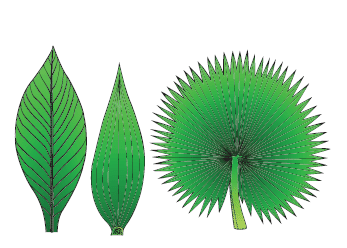The leaf is one of the most essential and noticeable parts of a plant. It is the primary organ of photosynthesis, where plants convert sunlight into energy. Besides photosynthesis, leaves perform a variety of functions vital to the survival of the plant. In this blog post, we will explore the characteristic features of leaves, their functions, and an in-depth look at the different parts of a leaf along with venation patterns.
I. Characteristics of the Leaf
Leaves have a unique structure that sets them apart from other parts of the plant. Some of the characteristic features of leaves include:
- Green in Color: Due to the presence of chlorophyll, leaves are typically green, enabling them to perform photosynthesis.
- Flat and Thin Structure: This maximizes the surface area available for absorbing sunlight and exchanging gases.
- Borne on the Stem: Leaves emerge from the stem at nodes and are often positioned in a way to receive maximum sunlight.
- Simple or Compound: Leaves can either be simple (having a single leaf blade) or compound (having multiple leaflets attached to a single petiole).
- Presence of Stomata: Small openings called stomata are present on the leaf surface for gas exchange.
- Symmetry: Most leaves have bilateral symmetry, meaning they are mirror images on both sides.
- Attachment: Leaves can either be sessile (without a petiole) or petiolate (with a petiole attaching them to the stem).
II. Functions of the Leaf
Leaves perform several crucial functions that support the overall well-being of the plant:
- Photosynthesis: The most important function of the leaf is to produce food for the plant through the process of photosynthesis. Chlorophyll absorbs sunlight, and with the help of carbon dioxide and water, it produces glucose and oxygen.
- Transpiration: Leaves regulate water movement through a process called transpiration, where water evaporates from the surface of the leaf, helping in temperature regulation and maintaining water balance in the plant.
- Gaseous Exchange: Through tiny pores called stomata, leaves allow oxygen to exit and carbon dioxide to enter, which is essential for photosynthesis and respiration.
- Storage: In some plants, leaves can store food, water, or nutrients. For example, onion bulbs store food in their fleshy leaves.
- Protection: Some leaves are modified into spines (e.g., cactus) to protect the plant from herbivores.
- Vegetative Propagation: In some plants like Bryophyllum, new plants can grow from the leaf margins, aiding in vegetative reproduction.
 >
>III. Parts of the Leaf
A typical leaf consists of three main parts: the leaf base (hypopodium), petiole (stipe or mesopodium), and lamina (leaf blade).
1. Leaf Base (Hypopodium)
- Location: The leaf base is the part of the leaf attached to the stem.
- Stipules: Some leaves have small leaf-like structures at the base, called stipules, which may serve as protection or support.
- Pulvinus: In certain plants like legumes, the leaf base is swollen to form a structure known as the pulvinus, which allows leaf movement in response to external stimuli.
2. Petiole (Stipe or Mesopodium)
- Function: The petiole is the stalk that connects the leaf blade to the stem.
- Structure: It helps in positioning the leaf for maximum sunlight exposure and allows flexibility to the leaf. In some leaves, the petiole may be absent, making the leaf sessile.
3. Lamina (Leaf Blade)
- Structure: The lamina is the flat, thin, and usually broad part of the leaf.
- Photosynthesis: The lamina contains the chloroplasts, where photosynthesis occurs.
- Shape and Size: The shape, size, and texture of the lamina vary significantly from plant to plant.
- Veins: The lamina is traversed by veins, which contain vascular bundles for the transport of water, nutrients, and food.
Venation in Leaves
 >
>Venation refers to the arrangement of veins in the leaf blade. Veins provide mechanical support, facilitate the transport of water and nutrients, and are important for the distribution of food produced in the leaf.
I. Reticulate Venation
- Definition: In this pattern, the veins form a network throughout the leaf blade.
- Common in: Dicotyledonous plants (e.g., mango, hibiscus).
- Characteristics: A prominent midrib is present, with lateral veins branching off and forming a web-like structure.
II. Parallel Venation
- Definition: In parallel venation, the veins run parallel to each other without forming a network.
- Common in: Monocotyledonous plants (e.g., grass, banana).
- Characteristics: The veins are straight and run longitudinally along the length of the leaf blade, giving the leaf a striped appearance.
Conclusion
The leaf is not just a simple green structure but a vital organ performing multiple critical functions like photosynthesis, transpiration, and gaseous exchange. Its distinct parts—the leaf base, petiole, and lamina—each serve important roles in supporting the plant. The arrangement of veins in leaves, known as venation, also plays a crucial role in nutrient transport and mechanical support. Understanding the leaf’s structure and functions provides insight into its importance in plant physiology and its adaptations to various environmental conditions.